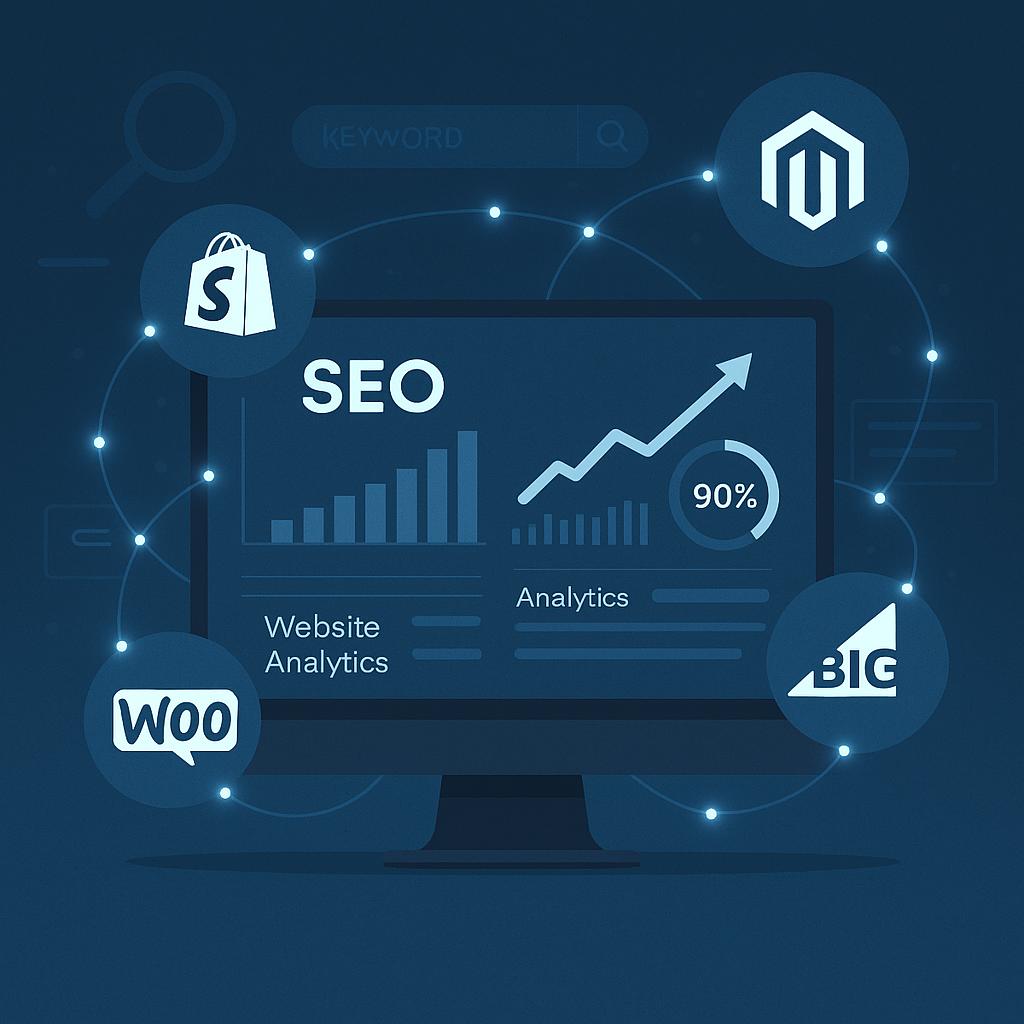Finding the best ecommerce platform for SEO means answering this question: which platform makes it easiest for search engines to understand products, content, and customer intent.
The ideal choice helps users build clean architecture and ship fast pages. It also lets them scale without replatforming every two years.
This guide narrows the focus: it highlights the important features, shows how to evaluate them, and offers practical examples.
The goal is to help decision‑makers find solutions with clear criteria and fewer surprises later.
What Are the Features of the Best Ecommerce Platform for SEO?
The best ecommerce platform for SEO helps search engines understand the site and provides control over how each page appears in results. It also makes it easy to create useful content and organize products. In ideal scenario everything is fast and crawlable as catalogs grow.
But, no platform is perfect. The best fit depends on catalog size, team skill, and required integrations.
In the next sections, we’ll look at five key areas that matter most: site structure, content management, on-page control, performance, and analytics. Together, they define how well a platform supports long-term visibility and growth.
1. A Clear and Search-Friendly Site Structure
A clear structure helps search engines and shoppers understand how products relate. Categories should map to real queries, and filters should reflect attributes people actually use.
Short, descriptive URLs make life easier. Category pages should summarize key choices and route visitors to subcategories or filtered views.
Breadcrumbs reinforce context and give internal link structure more meaning.
For stores with many variants, product detail pages should consolidate color or size options to avoid thin duplicates. Canonical tags can point to the main URL while still letting shoppers filter, sort, and compare.
Features That Help Search Engines Crawl and Index Your Store
The platform should prevent crawl traps and expose a stable path to every important page.
- XML sitemaps segmented by product, collection, CMS, and blog
- Robots rules that block unimportant parameters and internal search results
- Pagination that uses clean URLs and prevents infinite scroll issues
- Canonicals set in templates for product variants and sorting
- Auto‑generated and editable breadcrumbs
Internal linking patterns is important as much as the tools. Smart cross‑links from category descriptions, related items, and editorial content help crawlers discover new stock keeping units (SKU) quickly.
2. Simple Content Creation and Management
Search favors stores that answer buyer questions with helpful content. Product guides, blog posts, comparison charts, and FAQs work especially well for that purpose
Long‑form pieces can support buying process when they connect to category pages and product bundles.
To make that possible, the platform should let you write and publish quickly without breaking page speed.
Content should reinforce product discovery. The right setup makes that easier:
- One login and shared media library keep assets organized
- Shared components speed up updates across product and blog content
- Author fields, categories, and tags create logical clusters
- Scheduled publishing helps coordinate new product drops with content
If you want to see how it looks in practice, try Stryng for free. It’s an AI-powered, all-in-one content marketing platform designed for smooth creation and publishing of SEO-friendly content. This makes Stryng especially effective for ecommerce.
With just a few clicks, you can set key parameters like keyword, length, tone of voice, meta descriptions, and internal linking, plus many more options to customize your content.
If producing content for your site feels too time-consuming, contact the Stryng team and they’ll take care of everything.
3. On-Page SEO Control
On‑page elements should be effortless to manage at scale. Templates must support variables like product title, brand, category, price range, and availability.
A platform that enforces consistent heading hierarchy reduces accessibility and SEO errors. Editors should set H1 once per page while subheadings and specs use H2/H3 in logical order.
Bulk editing of metadata and redirects is a time saver during migrations and product retirements.
Customizing Titles, Descriptions, and Headings
Titles and descriptions influence click‑through and context.
Template‑level rules should allow:
- Patterns like {Product Name} | {Category} | {Brand}
- Conditional text for sale items or back‑in‑stock notices
- Per‑page overrides for priority SKUs
Meta descriptions deserve attention. Well‑written snippets can improve SERP engagement for high‑impression pages.
Image Optimization, Alt Text, and File Names
Images carry SEO weight and conversion power. Platforms should automate compression and support modern formats without complex setup.
Editors need fields for alt text that describe the product or feature shown.
File names should follow rules like brand‑model‑color.jpg instead of img_123.jpg. Responsive images with srcset reduce payload on mobile and preserve quality on desktop.
4. Fast, Mobile-Friendly Performance
Speed influences visibility and revenue. Clean HTML, minimal blocking scripts, and optimized images reduce load time and improve engagement.
Platforms that prioritize server‑side rendering and smart caching often fare better on long category pages.
Theme choices are important too. Lightweight templates with fewer third‑party scripts keep performance predictable.
Page Speed and Technical Health
Core Web Vitals quantify user experience. Good scores correlate with better engagement and lower bounce rates.
- Largest Contentful Paint should render fast on category and product pages
- Interaction to Next Paint matters on script‑heavy PDPs
- Cumulative Layout Shift stays low when image dimensions are defined
In plain language:
- Make sure the main content loads fast.
- Make sure clicks and interactions happen quickly.
- Make sure the layout doesn’t jump around while loading.
Continuous testing is wise after theme updates or app installs. A clear rollback process protects organic revenue when changes slow the site.
Responsive Design and Mobile Usability
Most product discovery starts on phones. Templates should adapt gracefully to small screens and limited bandwidth.
Readable fonts, finger‑friendly filters, and clear add‑to‑cart buttons improve mobile ecommerce SEO outcomes.
Category filters must be scrollable, and sticky CTAs should not block content.
On product pages, galleries need swipe support and quick access to size guides and shipping details.
If mobile content needs tightening, optimize it for mobile phone users.
5. Scalability and Growth Support
SEO success introduces scaling challenges. The platform must handle more SKUs, regions, and content without collapsing under complexity.

Managing Large Catalogs and Expanding Content
Large catalogs expose crawl budget limits. The platform should help prioritize important URLs and minimize noise.
It can block low-value filter combinations and use canonicals to point filtered pages to the main category or product.
Static snapshots help critical category pages with heavy JavaScript, and bulk editing of titles and schema keeps seasonal lines up to date.
Multi-Language and Multi-Region SEO Options
International growth adds complexity to URL design and metadata. The platform should support:
- Subfolders or subdomains per locale with separate sitemaps
- Native hreflang generation for page pairs across languages and regions
- Local currency and shipping details in structured data
- Regional canonical rules to avoid duplication across storefronts
Measuring What Makes an Ecommerce Platform the Best for SEO
Core diagnostics to review weekly:
- Crawl coverage for product and category templates
- Indexation percentage by content type
- Core Web Vitals for top revenue pages
- Non‑brand queries gained for key categories
- Click‑through rate changes after template updates
- Organic revenue and margin by landing page
Helpful tools and views:
- Google Search Console’s performance and indexing reports for trend spotting
- GA4 or another analytics platform for assisted conversions and cohort behavior
- A crawler to validate metadata, canonicals, and schema across templates
- Server logs or crawl stats to find traps and orphan pages
- A rank tracker for a realistic set of category and product queries
A simple 5‑step evaluation process can keep platform choices grounded:
- Map the catalog to a future‑proof taxonomy with 12 to 18 primary categories.
- List required template variables for titles, descriptions, schema, and breadcrumbs.
- Define performance budgets for HTML, CSS, JS, and images on category and product pages.
- Validate internationalization needs: URL structure, hreflang, pricing, and logistics fields.
- Test publishing workflow speed by shipping a mock product line and a 1,500‑word guide.
Comparison of Platforms as They Relate to SEO Essentials
As we’ve already said, there’s no perfect platform as such; a platform is only perfect in the context of a particular business.
| Platform | URL Control | Meta & Headings | Blog/CMS | Notable Considerations |
|---|---|---|---|---|
| Shopify | Good, some path constraints | Template variables + per page | Built‑in blog | Facets and filters need care to prevent duplication |
| WooCommerce | Full via WordPress | Robust via SEO plugins | Excellent with WP | Highly flexible, requires upkeep |
| BigCommerce | Clean, server‑rendered | Template logic + per page | Built‑in | Scales well for larger catalogs |
| Adobe Commerce (Magento) | Very granular | Advanced templating | Built‑in | Enterprise flexibility, dev resources needed |
| Wix | Improved controls | Page‑level edits + some templates | Built‑in | Easiest setup, fewer enterprise levers |
| Squarespace | Basic control | Simple edits | Strong blog | Less suited to very large catalogs |
Final Thoughts
The best ecommerce platform for SEO is the one that supports speed and accuracy in content publishing, and maintains clean structure as the catalog grows.
Control at the template level matters most because it scales. Measurement ties it all together and makes decisions objective.
Search success comes from consistent execution. A platform that simplifies everyday SEO tasks will outperform clever workarounds over time.
The ideas in this guide reflect widely accepted best practices and recognized documentation, with practical examples that teams can adapt to their context.
Frequently Asked Questions
Q: Which platform is most SEO friendly for a small catalog?
A: For a small store, simplicity helps. Platforms with built‑in blog tools, clean templates, and easy redirects are usually enough. Mobile ecommerce SEO should stay front and center because most first visits happen on phones.
Q: What matters more, platform choice or content quality?
A: Both matter, but content usually wins long term. A solid platform keeps the site fast and crawlable, while helpful guides and category summaries answer customer questions and earn rankings.
Q: How should teams handle product variants for SEO?
A: Consolidate variants on a single product page when possible. Use canonical tags for filtered URLs and keep unique content focused on the main product version.
Q: Which metrics best reflect SEO progress for online stores?
A: Indexation of key templates, Core Web Vitals, non‑brand impressions and clicks for category terms, and revenue by landing page. These track technical health and buyer intent together.
Q: Are ecommerce SEO tools necessary with a strong platform?
A: A good platform covers most essentials. Tools still help with crawling, schema validation, rank tracking, and reporting. They save time and catch issues before they affect customers.
Q: How can international stores avoid duplicate content issues?
A: Use clear URL structures per region, implement hreflang, and align pricing and shipping details with the correct locale. Keep sitemaps segmented by market for easier monitoring.
Q: What is the fastest way to test a platform before committing?
A: Build a small proof of concept with one category, five products, and a 1,000‑word guide. Validate titles, meta descriptions, schema, and Core Web Vitals. That reveals most limits in a week.
Q: Where does technical SEO for ecommerce usually break?
A: Faceted navigation, pagination, and parameter handling often create crawl traps. Careful canonical rules and sitemap hygiene prevent wasted crawl budget.



